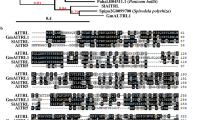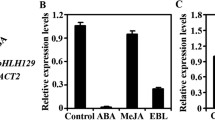Abstract
Key message
The Arabidopsis AP2/ERF family transcription factor AtERF15 is nuclear-localized and positively regulates ABA and stress responses.
Abstract
Abscisic acid (ABA) is a major plant hormone that controls the expression of hundreds genes involved in various aspects of plant growth and development, such as seed development, germination, seedling growth and abiotic stress response. Several cis-elements mediating the ABA-regulated gene expression have been reported, and one of the regulatory elements is Coupling Element 1 (CE1). We previously isolated a group of AP2/ERF family proteins that bind CE1, but their functions are mostly unknown. In this study, we demonstrate that one of the CE1 binding factors (CEBFs), AtERF15, is involved in ABA response. To investigate the AtERF15 function, we generated its overexpression (OX) lines by expressing the AtERF15 coding region under the control of CaMV 35S promoter and analyzed their phenotypes. We found that the AtERF15 OX lines were hypersensitive to ABA at the germination stage. The ABA hypersensitivity was also observed in our root elongation assay of seedlings. Furthermore, the transgenic lines were hypersensitive to high salinity and high osmolarity at the seedling establishment stage, and the transgenic seedlings were drought-tolerant. We also determined the tissue-specific expression pattern and the subcellular localization of AtERF15. Our results indicate that it is highly expressed in roots and embryos and nuclear-localized. Collectively, our data suggest that AtERF15 is a positive regulator of ABA response.








Similar content being viewed by others
Abbreviations
- ABA:
-
Abscisic acid
- RT-PCR:
-
Reverse transcription-polymerase chain reaction
- EYFP:
-
Enhanced yellow fluorescent protein
References
Bechtold N, Pelletier G (1998) In planta Agrobacterium-mediated transformation of adult Arabidopsis thaliana plants by vacuum infiltration. Methods Mol Biol 82:259–266
Berrocal-Lobo M, Molina A, Solano R (2002) Constitutive expression of ETHYLENE-RESPONSE-FACTOR1 in Arabidopsis confers resistance to several necrotrophic fungi. Plant J 29:23–32
Busk PK, Pages M (1998) Regulation of abscisic acid-induced transcription. Plant Mol Biol 37:425–435
Choi H, Hong J, Ha J, Kang J, Kim SY (2000) ABFs, a family of ABA-responsive element binding factors. J Biol Chem 275:1723–1730
Cutler SR, Rodriguez PL, Finkelstein RR, Abrams SR (2010) Abscisic acid: emergence of a core signaling network. Annu Rev Plant Biol 61:651–679
Finkelstein R (2013) Abscisic acid synthesis and response. Am Soc Plant Biol 11:e0166
Finkelstein RR, Lynch TJ (2000) The Arabidopsis abscisic acid response gene ABI5 encodes a basic leucine zipper transcription factor. Plant Cell 12:599–609
Fujita Y, Fujita M, Shinozaki K, Yamaguchi-Shinozaki K (2011) ABA-mediated transcriptional regulation in response to osmotic stress in plants. J Plant Res 124:509–525
Hobo T, Asada M, Kowyama Y, Hattori T (1999) ACGT-containing abscisic acid response element (ABRE) and coupling element 3 (CE3) are functionally equivalent. Plant J 19:679–689
Jefferson RA, Kavanagh TA, Bevan MW (1987) GUS fusions: β-glucuronidase as a sensitive and versatile gene fusion marker in higher plants. EMBO J 20:3901–3907
Kang JY, Choi HI, Im MY, Kim SY (2002) Arabidopsis basic leucine zipper proteins that mediate stress-responsive abscisic acid signaling. Plant Cell 14:343–357
Kim SY (2006) The role of ABF family bZIP class transcription factors in stress response. Physiol Plant 126:519–527
Lee SJ, Cho DI, Kang JY, Kim SY (2009) An ARIA-interacting AP2 domain protein is a novel component of ABA signaling. Mol Cells 27:409–416
Lee SJ, Park JH, Lee MH, Yu JH, Kim SY (2010) Isolation and functional characterization of CE1 binding proteins. BMC Plant Biol 10:277
Lee SJ, Jung HJ, Kang H, Kim SY (2012) Arabidopsis zinc finger proteins AtC3H49/AtTZF3 and AtC3H20/AtTZF2 are involved in ABA and JA responses. Plant Cell Physiol 53:673–686
Leon-Kloosterziel KM, Gil MA, Ruijs GJ, Jacobsen SE, Olszewski NE, Schwartz SH, Zeevaart JA, Koornneef M (1996) Isolation and characterization of abscisic acid-deficient Arabidopsis mutants at two new loci. Plant J 10:655–661
Lopez-Molina L, Chua N-H (2000) A null mutation in a bZIP factor confers ABA-insensitivity in Arabidopsis thaliana. Plant Cell Physiol 41:541–547
Lorenzo O, Piqueras R, Sanchez-Serrano JJ, Solano R (2003) ETHYLENE RESPONSE FACTOR1 integrates signals from ethylene and jasmonate pathways in plant defense. Plant Cell 15:165–178
Matsui A, Ishida J, Morosawa T, Okamoto M, Kim JM, Kurihara Y, Kawashima M, Tanaka M, To TK, Nakaminami K, Kaminuma E, Endo TA, Mochizuki Y, Kawaguchi S, Kobayashi N, Shinozaki K, Toyoda T, Seki M (2010) Arabidopsis tiling array analysis to identify the stress-responsive genes. Methods in Mol Biol 639:141–155
McGrath KC, Dombrecht B, Manners JM, Schenk PM, Edgar CI, Maclean DJ, Scheible WR, Udvardi MK, Kazan K (2005) Repressor- and activator-type ethylene response factors functioning in jasmonate signaling and disease resistance identified via a genome-wide screen of Arabidopsis transcription factor gene expression. Plant Physiol 139:949–959
Menkens AE, Schindler U, Cashmore AR (1995) The G-box: a ubiquitous regulatory DNA element in plants bound by the GBF family of bZIP proteins. Trend Biochem Sci 20:506–512
Nakano T, Suzuki K, Fujimura T, Shinshi H (2006) Genome-wide analysis of the ERF gene family in Arabidopsis and rice. Plant Physiol 140:411–432
Nemhauser JL, Hong F, Chory J (2006) Different plant hormones regulate similar processes through largely nonoverlapping transcriptional responses. Cell 126:467–475
Pre M, Atallah M, Champion A, De Vos M, Pieterse CM, Memelink J (2008) The AP2/ERF domain transcription factor ORA59 integrates jasmonic acid and ethylene signals in plant defense. Plant Physiol 147:1347–1357
Sakuma Y, Liu Q, Dubouzet JG, Abe H, Shinozaki K, Yamaguchi-Shinozaki K (2002) DNA-binding specificity of the ERF/AP2 domain of Arabidopsis DREBs, transcription factors involved in dehydration- and cold-inducible gene expression. Biochem Biophys Res Commun 290:998–1009
Shen Q, Ho TH (1995) Functional dissection of an abscisic acid (ABA)-inducible gene reveals two independent ABA-responsive complexes each containing a G-box and a novel cis-acting element. Plant Cell 7:295–307
Shen Q, Zhang P, Ho TH (1996) Modular nature of abscisic acid (ABA) response complexes: composite promoter units that are necessary and sufficient for ABA induction of gene expression in barley. Plant Cell 8:1107–1119
Uno Y, Furihata T, Abe H, Yoshida R, Shinozaki K, Yamaguchi-Shinozaki K (2000) Arabidopsis basic leucine zipper transcription factors involved in an abscisic acid-dependent signal transduction pathway under drought and high-salinity conditions. Proc Natl Acad Sci USA 97:11632–11637
Voinnet O, Rivas S, Mestre P, Baulcombe D (2003) An enhanced transient expression system in plants based on suppression of gene silencing by the p19 protein of tomato bushy stunt virus. Plant J 33:949–956
Werner JE, Finkelstein RR (1995) Arabidopsis mutants with reduced response to NaCl and osmotic stress. Physiol Plant 93:659–666
Xiong L, Schumaker KS, Zhu JK (2002) Cell signaling during cold, drought, and salt stress. Plant Cell 14(Suppl):S165–S183
Yoshida T, Fujita Y, Sayama H, Kidokoro S, Maruyama K, Mizoi J, Shinozaki K, Yamaguchi-Shinozaki K (2010) AREB1, AREB2, and ABF3 are master transcription factors that cooperatively regulate ABRE-dependent ABA signaling involved in drought stress tolerance and require ABA for full activation. Plant J 61:672–685
Acknowledgments
This work was supported in part by grants from the Mid-career Researcher Program through NRF Grant funded by the Ministry of Education, Science and Technology (MEST) (No. 2011-0015455 to S.Y.K.) and the Rural Development Administration, Republic of Korea (the Next Generation BioGreen 21 Program, Grant PJ008198 to S.Y.K.). The authors are grateful to the Kumho Life Science Laboratory of Chonnam National University for providing equipment and plant growth facilities.
Conflict of interest
The authors declare that they have no conflict of interest.
Author information
Authors and Affiliations
Corresponding author
Additional information
Communicated by Jeong Sheop Shin.
Electronic supplementary material
Below is the link to the electronic supplementary material.
Rights and permissions
About this article
Cite this article
Lee, Sb., Lee, Sj. & Kim, S.Y. AtERF15 is a positive regulator of ABA response. Plant Cell Rep 34, 71–81 (2015). https://doi.org/10.1007/s00299-014-1688-2
Received:
Revised:
Accepted:
Published:
Issue Date:
DOI: https://doi.org/10.1007/s00299-014-1688-2




